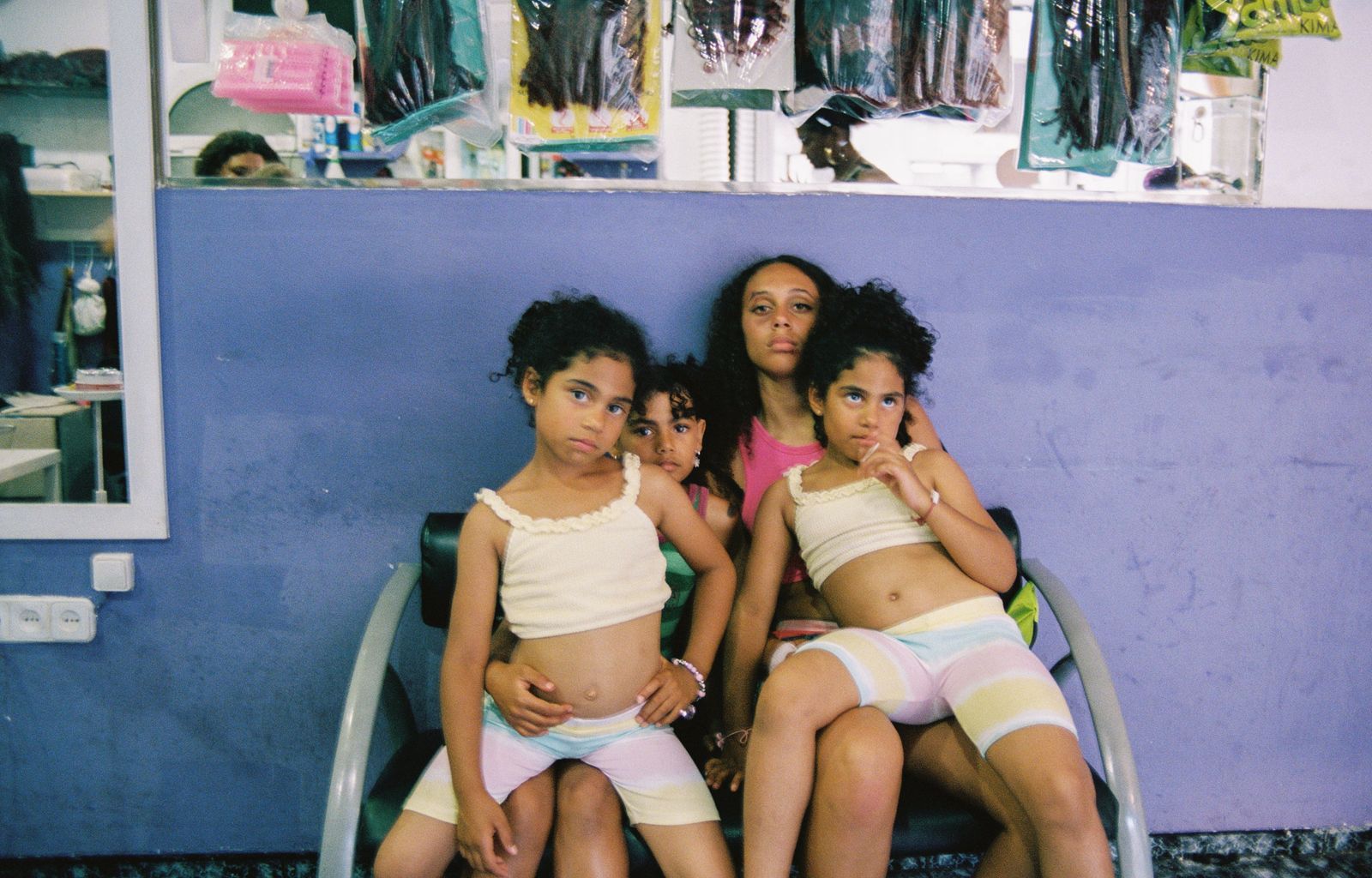Choosing to Stay
Interview with Lucia G. Romero
Lucia G. Romero’s queer summer romance Close to September is full of emotionally charged moments. In an interview with Hana Kreševič, the writer-director opens up about abandonment and improvisation.

Watching Close to September (Casi Septiembre) felt like watching an excerpt from my own life. I was lucky enough to see it before it screened at Curtas Vila do Conde in July this year, and I remember it vividly—that tightness in my chest, as though my heart was about to leap out. There was something about the way the two characters moved around each other—with familiarity, restraint, and a kind of haunted tenderness—that felt deeply familiar. Maybe it’s because I’m queer, too. The closeness, the confusion, the emotional elasticity—I’ve lived it. Not in Costa Brava. Not in September. But still. Something in it touched a place I hadn’t realised was still so raw.
It’s 8 p.m. on Saturday, July 13th, and writer-director Lucía G. Romero and I are sitting just outside Vila do Conde’s Teatro Municipal, the festival’s main screening venue. Curtas has only just begun, and after thirty sleepless hours and a brief, disoriented nap, I meet Romero to talk about her tender, disarming short. Romero is the first filmmaker I’ve ever interviewed, but from the moment we sit down, ours doesn’t feel like an interview so much as a catch-up with an old friend—the kind of chat that effortlessly slips into musings about love, memory, and all the things you thought you’d left behind.
Close to September is Romero’s second short film. It’s a follow-up to Cura Sana (2024), which premiered at the 74th Berlinale in the Generation 14plus section, and went on to win the Crystal Bear for Best Short Film. “I wanted to tell the story of a girl who, although she seems strong and fearless,” Lucía says of that earlier work, “is afraid of being vulnerable and letting her guard down because of her experience with abuse—and how that affects her life and relationships.”
Much like Cura Sana, Close to September also navigates themes of abandonment, along with the instinct to build walls so high that it becomes nearly impossible for anyone to break through them. When I ask what inspired her latest, Romero tells me she wanted to explore “what it’s like to live with a fear of abandonment, and what it’s like to desire a connection so much—but to be so afraid that you’re going to be hurt or abandoned again, that you just self-sabotage.” She speaks about this subject with striking conviction, especially when discussing how it’s usually portrayed in more mainstream, commercial cinema. “I was so used to seeing it represented in such a cliché way, as if people who struggle with these fears are always the antagonist—the bad person in the story.”
Romero sets the entire film in a secluded campsite in Costa Brava, a liminal space that befits a story about people in transit. At the heart of it is Alejandra, a young woman who has made the campsite her home. The plan had always been to shoot in the summer, in a campsite. But as the project developed, she saw the opportunity to use the setting as a reflection of Alejandra’s inner world: “[Ale] felt like people could just come in, take from her, and leave.” For Romero, the campsite isn’t just literal—it’s also symbolic, a kind of emotional shield. “She knows she’ll have summer romances with people passing through. She also knows they’ll leave. So she doesn’t give anyone the chance to get close.”
Everything changes for Alejandra when she meets la chica de la capital—Madrilenian Amara. Until that point, Alejandra moves through the world half-guarded, tethered to responsibilities, weighed down by the unspoken. Amara’s arrival doesn’t blow anything open, but it introduces something unfamiliar: attention, softness, the possibility of being seen without having to explain yourself. Romero herself opens up as I ask her about the casting process. “Ana is my ex-girlfriend,” she smiles. Alejandra was written with her in mind from the start—the role was always hers. The character of Amara came later. There were a few options as to who might play her, and Ana was actively involved in choosing, though ultimately, Romero made the final call. She picked Isabel because she matched what she had envisioned for the character and, crucially, because there was “a little bit of sexual tension.”

© Cura sana (Lucía G. Romero, 2024)
That tension is undeniable. The chemistry between Ana and Isabel is electric, not performative, but lived-in. Oftentimes during the film, I felt like an eavesdropper; the private, tender moments they exchange are clearly not meant for the public eye. Close to September doesn’t feel like a work of fiction, nor do its characters. Maybe it’s because the chemistry is so palpable, or maybe it’s because Romero gave the actors space to move and breathe. While she’s clear that Close to September was more scripted than Cura Sana, one of the most emotionally charged scenes—where characters wander the campsite—was entirely improvised. “It was just me, my director of photography [Gemma de Miguel], and the sound guy [Eduard Marti Farré],” she says. The only instructions the actors were given were when to turn left or right. The conversation, the laughter, all of it was theirs.
One of the reasons I ask about improvisation in her short is a small, beautiful sequence at the beach. Alejandra and her best friend and confidant, Omar, are walking along the shore when a paraglider flies above them. They shout, “Take me away! Take me with you!” The first time I saw Close to September, I barely noticed it. But on second viewing, the moment struck me—it felt too spontaneous, too alive to be scripted. I was right. “We hated the paraglider,” Romero jokes, recalling how the man kept interrupting takes with the sound of his engine. But one day, when he passed through the background unexpectedly, Romero changed her mind. “Wait—maybe this could work.” They signaled to him, had him repeat the flight a few times, and the shot became one of the most heartfelt moments in the entire film.
Some of the film’s most striking scenes take place between Alejandra and her three younger sisters—Carmen, Isabel, and Sofia. While their mother is off flirting with a guy running a nearby souvenir shop, the burden of care quietly falls on Alejandra. She washes her siblings’ hair, makes sure they eat, and even brings them along when she hangs out with friends. She serves as sister and surrogate parent, both, not because she wants to, but because someone has to. One scene in particular lingers with me: the girls are watching a movie on a dirty mattress that seems to have taken regular residence in front of the house. The little ones are laughing, joking around, seemingly unbothered by their mother’s absence. In front of them sits Alejandra, holding back tears. She cries silently, carefully, because someone has to be the strong one. Someone has to keep things together—to give them the illusion of a home, the kind Alejandra likely never had herself. And still, despite everything, she clearly loves them. That much is undeniable. They’re lucky to have her, even if they don’t yet know it.
There’s another beautifully loaded moment during the campsite’s end-of-season dance recital, open to local residents and tourists alike. The girls perform what Romero describes as a very famous Spanish pop song from her own childhood—one she remembers dancing to when she was five or six: Cuando Zarpe el Amor (When Love Sets Sail), by Camela. It’s a song every Spaniard would instantly recognise. But here’s the twist: the lyrics describe heartbreak. That irony isn’t lost in the scene—watching these girls dance innocently to a song about loss makes the moment feel both nostalgic and quietly devastating.
One of the most remarkable aspects about Close to September is the way Romero ties the film together—gently, but with intention. In one of the opening scenes, we see Alejandra walking alone by the beach, smoking a cigarette. In the final shot, we’re back in that same place: the young girl, the beach, the cigarette. At first glance, it feels like nothing has changed. She’s still alone. Amara, we assume, is just another summer fling she’ll forget when September passes. But when I ask Romero if this full-circle structure was always the plan, her answer is an immediate yes. Those beach scenes were written in the earliest stages of the script. “It’s very hard to achieve any kind of resolution in such a short film,” she tells me, “but I wanted it to be subtle.” And it is. The shift is small, but it matters. In the first scene, Alejandra walks the beach as a way of running—from vulnerability, from rejection, from connection. In the final scene, she walks the same path, but differently. This time, she’s not running. She’s choosing to stay with the weight of what just happened. By walking Amara to the train station, by saying goodbye without shutting down, she opens herself to uncertainty. She allows space for the relationship not to work out, and embraces that without fear.
Isn’t that what love is, in the end? Leaning into the unknown. Letting go of the need to protect yourself. Falling, not blindly, but willingly.
This text was developed during the European Workshop for Film Criticism #7—a tandem workshop set during Curtas Vila do Conde and FeKK – Ljubljana Short Film Festival—and edited by workshop tutor Leonardo Goi.
The European Workshop for Film Criticism is a collaboration of the European Network for Film Discourse (The END) and Talking Shorts, with the support of the Creative Europe MEDIA programme.




